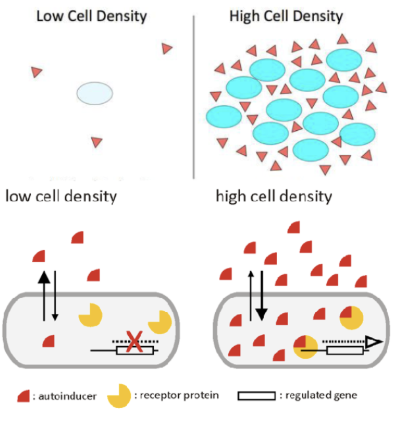chapter 10, community lifestyle of a biofilm
1/18
There's no tags or description
Looks like no tags are added yet.
Name | Mastery | Learn | Test | Matching | Spaced |
|---|
No study sessions yet.
19 Terms
planktonic lifestyles
free- living swimming bacteria growing in culture.
Single cells acting independently.
Typical in nutrient-rich, favorable conditions.
(Chemotaxis: signaling systems that regulates planktonic lifestyles)
biofilm
have a stationary lifestyle, non- motile, and stuck onto surfaces.
Growth is community based (bacteria).
This can help bacteria cope with harsh environmental conditions.
Include quorum sensing signaling.
Organized communities of bacteria that are adhered to a surface and surrounded by a matrix of extracellular polymeric substances.
The bacteria in the biofilm make the EPS.
A biofilm is made out of single bacterial species. But some biofilms could have hundreds of different species of bacteria living together
1000x more resistant to antimicrobials (from the EPS)
O2 availability varies
Extracellular polymeric substances (EPS)/ “biofilm matrix“
slimy, film-like substance that is produced by bacteria in the biofilm.
It is made out of polysaccharides, proteins, and nucleic acids
bacterial signaling systems: chemotaxis
bacteria sense environmental signal concentration gradients and respond. Such as motility towards nutrients
the process in which bacteria can sense chemical gradients in their environment and adjust their movement toward beneficial substances or away from harmful ones. This is a rapid individual response that does not require new gene expression. Chemotaxis provides a responsive and motile lifestyle of bacteria

quorum sensing
bacteria sense each other and coordinate responses as a group. Has bacterial communication
mechanism where prokaryotes can cooperate by sensing the presence of other organisms that are nearby in the environment.
They “talk to each other” by using chemicals to coordinate their activities.
It is a type of environmentally- regulated gene expression in which gene expression is regulated by population density.
It always needs an autoinducer(AI) that is a communication chemical
autoinducers AI (bacterial quorum sensing)
Bacteria secrete chemical communication molecules. The molecules are autoinducers!!
They are secreted constitutively.
# cells incr, # autoinducers incr. +ve trend.
They bind to response regulators, and they affect gene expression

global regulator (ex// in e. coli in low and high [AI2])
LsrR binding to AI2 affects LOTS of genes
regulate other regulators
Regulate other genes
Low AI2 conc | High AI2 conc |
1. LuxS produces Autoinducer-2 2. AI2 is secreted by YdgG into the environment 3. Global transcriptional regulator LsrR inhibits transcription of QS genes (repression) Secreted more than being taken up Low conc SI2= e. Coli is in isolation, there is not enough other e coli cells to be accumulated
| 1. LuxS produces Autoinducer-2 2. AI2 is secreted by YdgG into the environment 3. Cell imports AI2 into its cytosol through LsrABCD complex 4. AI2 is phosphorylated by the kinase LsrK 5. P-AI2 binds to LsrR, inhibits LsrR repression of QS genes 6. QS genes are expressed High AI2, high e. Coli
|

what is quorum sensing?
What is chemotaxis?
What are the signals in the each system and how are they detected?
What is the response to levels of high/low signal concentration?
1. describe characteristics of a biofilm and how it typically forms
2. distinguish between biofilms and planktonic cultures
3. describe features of biofilms that contribute to persistence and antimicrobial resistance
4. describe the molecular mechanisms of quorum sensing and chemotaxis in E. coli
5. apply your understanding of the E. coli quorum sensing and chemotaxis systems to other bacterial species
6. explain the role of quorum sensing and chemotaxis in biofilm formation
7. interpret data collected on biofilms, quorum sensing, and chemotaxis